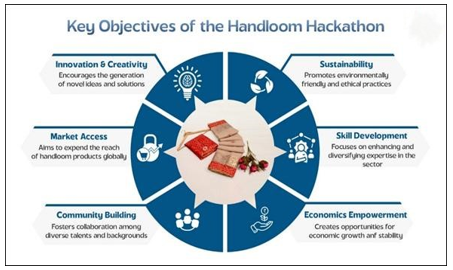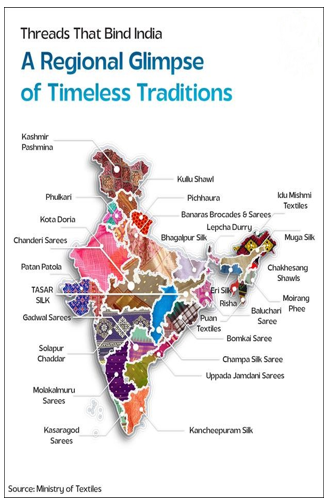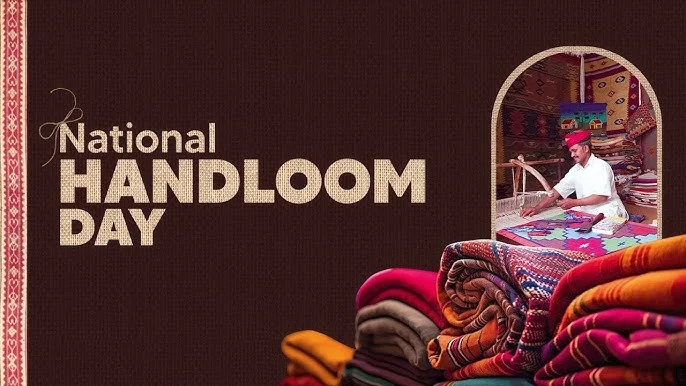SYLLABUS
GS-1: primary, secondary, and tertiary sector industries in various parts of the world (including India).
GS-3: Changes in industrial policy and their effects on industrial growth.
Context:
The Government of India celebrated the 11th National Handloom Day on 7th August 2025 at Bharat Mandapam, New Delhi.
More on the News

- The President of India has conferred the 2024 Sant Kabir Handloom Awards and National Handloom Awards to 24 awardees—5 Sant Kabir and 19 National Awardees.
- These awards are part of the Handloom Marketing Assistance (HMA) component under the National Handloom Development Programme (NHDP).
- They recognise the work of weavers, designers, marketers, start-ups and producer companies who have made a difference in the field.
- Sant Kabir Awardees receive ₹3.5 lakh, a gold coin (mounted), Tamrapatra, shawl, and certificate, while National Awardees get ₹2 lakh, Tamrapatra, shawl, and certificate.
- The Ministry of Textiles also launched the Handloom Hackathon 2025 at the Research and Innovation Park, IIT Delhi.
National Handloom Day

- National Handloom Day is observed annually on August 7 to commemorate the launch of the Swadeshi Movement in 1905, which promoted indigenous industries.
- The first celebration was held in 2015 in Chennai to honour the handloom weaving community’s contribution to India’s socio-economic growth.
- Since then, it is observed every year to recognise and celebrate the role of weavers in preserving India’s rich textile heritage.
India’s Handloom Sector
- Handloom weaving is India’s largest cottage industry and the second-largest employment sector after agriculture, crucial for rural livelihoods.
- As per the 4th All India Handloom Census (2019–20), about 35.22 lakh households are involved in handloom work, comprising over 35 lakh weavers and allied workers.
- Notably, 72% of economically active weavers are women, highlighting the sector’s role in women’s empowerment.
India is renowned for its diverse handloom fabrics, including:
- Natural fibres: cotton, khadi, jute, linen
- Rare fibres: Himalayan nettle
- Silks: Tussar, Mashru, Mulberry, Eri, Muga, Ahimsa
- Woollens: Pashmina, Shahtoosh, Cashmere
• Iconic products like Banarasi, Jamdani, and Patola are globally admired for their intricate craftsmanship.
• Other well-known styles include Bomkai from Odisha, Kunbi from goa, Paithani from Maharashtra, Kotpad from Oisha , Balarampuram from Kerala , Jamdani and Baluchari from West Bengal Each piece is handmade using traditional methods, making every product unique.
• India’s handloom exports in FY 2024-25 are as follows:

Government Initiatives for the Handloom Industry
• Mudra Scheme: it provides subsidised loans at 6% interest to individual weavers and organisations with margin money support. In 2024–25, 9,211 weavers benefited, and an online portal was created for direct transfer and transparency.
• Raw Material Supply Scheme (RMSS): It was approved for 2021–22 to 2025–26, ensuring the supply of quality yarn to weavers at subsidised rates to compete with the mill sector. It includes freight reimbursement and 15% yarn subsidy for cotton, silk, wool, linen, and blended yarns.
- Yarn Supply Scheme (YSS): It has now partially modified and renamed as the Raw Material Supply Scheme (RMSS), approved for the period 2021–22 to 2025–26.
• National Handloom Development Programme (NHDP): NHDP aims to promote the sustainable growth of handloom weavers in and outside recognised clusters by forming self-reliant and competitive units.
Source


